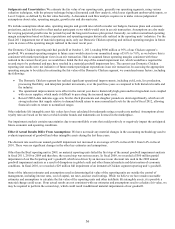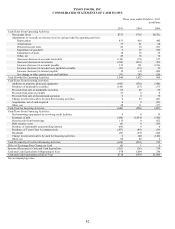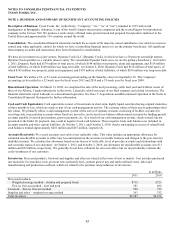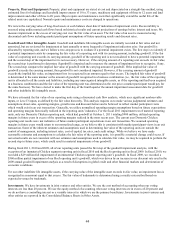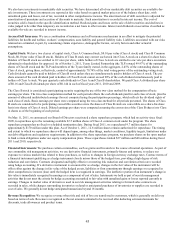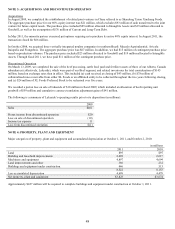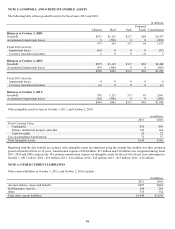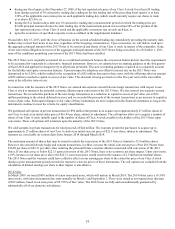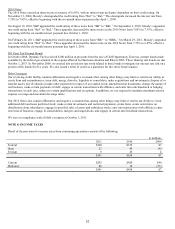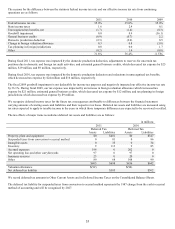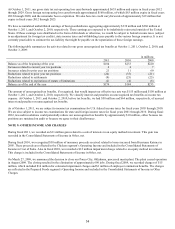Tyson Foods 2011 Annual Report Download - page 45
Download and view the complete annual report
Please find page 45 of the 2011 Tyson Foods annual report below. You can navigate through the pages in the report by either clicking on the pages listed below, or by using the keyword search tool below to find specific information within the annual report.45
We also have investments in marketable debt securities. We have determined all of our marketable debt securities are available-for-
sale investments. These investments are reported at fair value based on quoted market prices as of the balance sheet date, with
unrealized gains and losses, net of tax, recorded in other comprehensive income. The amortized cost of debt securities is adjusted for
amortization of premiums and accretion of discounts to maturity. Such amortization is recorded in interest income. The cost of
securities sold is based on the specific identification method. Realized gains and losses on the sale of debt securities and declines in
value judged to be other than temporary are recorded on a net basis in other income. Interest and dividends on securities classified as
available-for-sale are recorded in interest income.
Accrued Self Insurance: We use a combination of insurance and self-insurance mechanisms in an effort to mitigate the potential
liabilities for health and welfare, workers’ compensation, auto liability and general liability risks. Liabilities associated with our risks
retained are estimated, in part, by considering claims experience, demographic factors, severity factors and other actuarial
assumptions.
Capital Stock: We have two classes of capital stock, Class A Common Stock, $0.10 par value (Class A stock) and Class B Common
Stock, $0.10 par value (Class B stock). Holders of Class B stock may convert such stock into Class A stock on a share-for-share basis.
Holders of Class B stock are entitled to 10 votes per share, while holders of Class A stock are entitled to one vote per share on matters
submitted to shareholders for approval. As of October 1, 2011, Tyson Limited Partnership (the TLP) owned 99.97% of the outstanding
shares of Class B stock and the TLP and members of the Tyson family owned, in the aggregate, 2.45% of the outstanding shares of
Class A stock, giving them, collectively, control of approximately 70.74% of the total voting power of the outstanding voting stock.
Cash dividends cannot be paid to holders of Class B stock unless they are simultaneously paid to holders of Class A stock. The per
share amount of the cash dividend paid to holders of Class B stock cannot exceed 90% of the cash dividend simultaneously paid to
holders of Class A stock. We pay quarterly cash dividends to Class A and Class B shareholders. We paid Class A dividends per share
of $0.16 and Class B dividends per share of $0.144 in each of fiscal years 2011, 2010 and 2009.
The Class B stock is considered a participating security requiring the use of the two-class method for the computation of basic
earnings per share. The two-class computation method for each period reflects the cash dividends paid for each class of stock, plus the
amount of allocated undistributed earnings (losses) computed using the participation percentage, which reflects the dividend rights of
each class of stock. Basic earnings per share were computed using the two-class method for all periods presented. The shares of Class
B stock are considered to be participating convertible securities since the shares of Class B stock are convertible on a share-for-share
basis into shares of Class A stock. Diluted earnings per share were computed assuming the conversion of the Class B shares into Class
A shares as of the beginning of each period.
On May 11, 2011, we announced our Board of Directors reactivated a share repurchase program, which had no activity since fiscal
2005, to repurchase up to the remaining available 22.5 million shares of Class A common stock under the program. The share
repurchase program has no fixed or scheduled termination date. During fiscal 2011, we repurchased 9.7 million shares for
approximately $170 million under this plan. As of October 1, 2011, 12.8 million shares remain authorized for repurchase. The timing
and extent to which we repurchase shares will depend upon, among other things, market conditions, liquidity targets, limitations under
our debt obligations and regulatory requirements. In addition to the share repurchase program, we purchase shares on the open market
to fund certain obligations under our equity compensation plans. These repurchases totaled $37 million and $48 million during fiscal
2011 and 2010, respectively.
Financial Instruments: We purchase certain commodities, such as grains and livestock in the course of normal operations. As part of
our commodity risk management activities, we use derivative financial instruments, primarily futures and options, to reduce our
exposure to various market risks related to these purchases, as well as to changes in foreign currency exchange rates. Contract terms of
a financial instrument qualifying as a hedge instrument closely mirror those of the hedged item, providing a high degree of risk
reduction and correlation. Contracts designated and highly effective at meeting risk reduction and correlation criteria are recorded
using hedge accounting. If a derivative instrument is accounted for as a hedge, changes in the fair value of the instrument will be
offset either against the change in fair value of the hedged assets, liabilities or firm commitments through earnings or recognized in
other comprehensive income (loss) until the hedged item is recognized in earnings. The ineffective portion of an instrument’s change in
fair value is immediately recognized in earnings as a component of cost of sales. Instruments we hold as part of our risk management
activities that do not meet the criteria for hedge accounting are marked to fair value with unrealized gains or losses reported currently in
earnings. Changes in market value of derivatives used in our risk management activities relating to forward sales contracts are
recorded in sales, while changes surrounding inventories on hand or anticipated purchases of inventories or supplies are recorded in
cost of sales. We generally do not hedge anticipated transactions beyond 18 months.
Revenue Recognition: We recognize revenue when title and risk of loss are transferred to customers, which is generally on delivery
based on terms of sale. Revenue is recognized as the net amount estimated to be received after deducting estimated amounts for
discounts, trade allowances and product terms.



